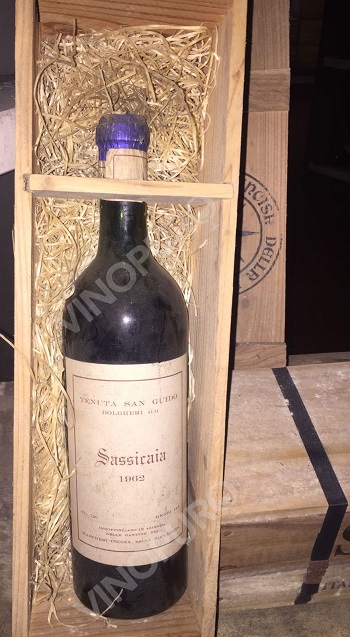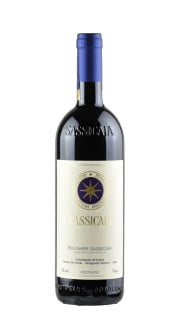- Immediate availability
Sassicaia
Sassicaia is one of the best wines in the world , among the most valuable, sought after and appreciated. The price of Sassicaia varies over time and the best vintages acquire value over the years. This wine has literally invented a new category of wines, namely the so-called Supertuscans, super-powerful and muscular Tuscan wines, mainly based on French vines (Cabernet and Merlot) and therefore not produced with local grapes, such as Sangiovese. Today the Bolgheri district is celebrated worldwide for the quality of its wines, important wineries have established themselves in the area over the years, creating equally "planetary" wines, in the footsteps of the eldest son "Sassicaia", a real forerunner. To celebrate the myth of Sassicaia, many prizes and awards especially in historical vintages such as 1985 and 2016, awarded with the very rare 100 points Robert Parker, guru of tasting, of the very prestigious American magazine Wine Spectator.
- € 399,00
The history of Sassicaia is the perfect representation of how the will, tenacity and, at times, the stubbornness of a man can get the better of everything and everyone (with a pinch of luck). But let's start from the beginning, the protagonists of the story are: the Marquises Incisa della Rocchetta, a noble Piedmontese family, the Antinori and della Gherardesca families, the oenologist Giacomo Tachis and, of course, the San Guido estate .
We are in Bolgheri, in the Province of Livorno, an area at the time (we are in the 1930s) very little suited to the production of wine; in the area, 3 typical wines were produced and they were: a white wine, a vin santo and, subsequently, a rosé. So no tradition on red wines. Marquis Mario Incisa della Rocchetta, from Asti, studied agriculture in Pisa; he is a great horse lover and during a reception organized by Federico Tesio, (great breeder of thoroughbreds) Clarice della Gherardesca: he falls in love with her and shortly after gets married, right in Bolgheri where Clarice, related to the Antinori family (formerly at the time an important wine producer), with the marriage he brings as a dowry over six hundred hectares of land with about ten farms. Meanwhile, in 1932, Mario Incisa della Rocchetta entered into a partnership with Tesio and thus the first nucleus of the legendary Dormello-Olgiata horse breed (and stable) was born; for the record, 20 years later, the legendary thoroughbred RIBOT will be born and in the 50s and 60s will win everything there is to win in the world of horse racing, on a global level.
But the Marquis Mario also has other plans: in fact, he has made up his mind to make a wine, a great wine, "like those French people from Bordeaux", which he knows very well through his friend Baron Rothschild and the frequent visits does in his prestigious chateau in Bordeaux. But he only wants to do it for himself and his family, he has no production and marketing ambitions. He immediately had an intuition: he believed that typical vines from the French area should be used, especially the Cabernet. The decision to plant these varieties in the Tenuta San Guido, in Bolgheri (owned by his wife), is partly due to the similarity he notes between this area of Tuscany and the Graves in Bordeaux. Grave means gravel and the Bordeaux area takes its name from the stony soil that distinguishes the local area: just like the area called Sassicaia on his wife's estate, precisely in Bolgheri. In 1944, Mario bought some Cabernet Sauvignon cuttings from the Marquises Salviati of Migliarino Pisano. From them, in fact, he had tasted a wine that closely reminded him of Bordeaux wines. And here the "myth" that the rooted cuttings had been bought by his friend Baron Rothschild is dispelled, even if the inspiration always remains France, of course.
The first family harvests are adventurous, the cellar is amateurish and rudimentary: the wine is not much (just a couple of hectoliters) and all the estate owners to whom the marquis lets it taste, say that the wine "has fire, it makes disgust". His friend the Baron of Rothschild is also involved, but he isn't enthusiastic either. The  Marquis Mario, however, does not give up; he tenaciously continues his work and applies the systems observed in France, including drastic pruning in the vineyard, to obtain no more than 350 grams of small bunches of Cabernet per single plant, a heresy for the time. These are nothing short of splendid, rich in substance and compact, but the vinification is not correct, the cellar is not adequate for the decidedly unique peculiarities of this grape. The marquis, not at all discouraged, continued trial after trial, throughout the 1950s, a stubbornness that was nothing short of admirable. In 1962, new tastings show that that wine, initially rough and kicking, over the years is transforming into something very different and that slowly resembles more and more those Bordeaux wines, as he said. In that period, a nephew of Mario, the Marquis Carlo Guerrieri Gonzaga, entered the cellar, today an established producer in Trentino with the famous Tenuta San Leonardo. Carlo is young, fresh from his studies at the Lycée Agricole in Lausanne and brings substantial innovations, including fermentation in wooden vats: they are barrels built by Italbotti of Conegliano Veneto and look exactly like the current barriques, and in fact they are made hoc, on the French model. And a very delicate Wilmess rubber lung press also arrives, a real gem for the time, which definitively retires the old traditional press present on the estate.
Marquis Mario, however, does not give up; he tenaciously continues his work and applies the systems observed in France, including drastic pruning in the vineyard, to obtain no more than 350 grams of small bunches of Cabernet per single plant, a heresy for the time. These are nothing short of splendid, rich in substance and compact, but the vinification is not correct, the cellar is not adequate for the decidedly unique peculiarities of this grape. The marquis, not at all discouraged, continued trial after trial, throughout the 1950s, a stubbornness that was nothing short of admirable. In 1962, new tastings show that that wine, initially rough and kicking, over the years is transforming into something very different and that slowly resembles more and more those Bordeaux wines, as he said. In that period, a nephew of Mario, the Marquis Carlo Guerrieri Gonzaga, entered the cellar, today an established producer in Trentino with the famous Tenuta San Leonardo. Carlo is young, fresh from his studies at the Lycée Agricole in Lausanne and brings substantial innovations, including fermentation in wooden vats: they are barrels built by Italbotti of Conegliano Veneto and look exactly like the current barriques, and in fact they are made hoc, on the French model. And a very delicate Wilmess rubber lung press also arrives, a real gem for the time, which definitively retires the old traditional press present on the estate.
In 1968 the first official vintage of Sassicaia was born. It is in fact a blend with wines also from 1966 and 1967 and, minimally, from 1965. In this period the star of the current logo makes its appearance, taken from the family crest of the Marquis Incisa and in subsequent vintages it will also be introduced Cabernet Franc to create the famous blend that we all know today. At this point, the production project becomes more precise and targeted: Mario makes an agreement, not without grumbling, with the Antinori cousins for the sale of Sassicaia through their extensive commercial network. By virtue of the commercial relationship, Giacomo Tachis, a young Piedmontese winemaker, already under the Antinori family, arrives in the cellar and from now on will follow the wine ever more closely. The quality that this product can express over time, let's say the potential, is increasingly recognized. The changes are numerous and Mario's semi-artisan choices are abandoned, with great effort and not without controversy. Marquis Mario doesn't have an easy character and being told what to do by someone outside the family complicates the situation. Moreover, being told what to do with his grapes, coming from his lands and what to do with his wine, in his cellar... And as if that weren't enough, being told by a Piedmontese boy, the son of a textile mechanic and a housewife: these were in fact the humble origins of Tachis. One of the crucial points of the dispute is certainly the fermentation of the wine: for Tachis it must take place at a controlled temperature in steel containers, while for the Marquis, strictly in wooden vats. And the funny thing is that the marquis will continue to do so even after the arrival of the steel vats, imposed "by reasons of state". In fact, starting from the 1977 harvest, the marquis will begin to produce a "clandestine Sassicaia", as he apparently jokingly called it himself, fermented in wood, in defiance of Tachis's recommendations, despite the fact that the wine (fermented in steel) had already made "fall in love " a large part of the market. And there was nothing to be done: until the end, Mario wanted to continue fermenting at least a little of his wine, of his grapes from his lands, in his own way. The winemaker was fine to sell, but to make "his" Sassicaia, those recommendations did not exist! The winemaker himself, in fact, did not exist for the Marquis. And in fact, even today, incredibly, Tachis is not mentioned even once on the official website of the estate, testifying to the difficult relations of the time. Facts and history, however, subsequently decreed the indubitable stature, worldwide, of the Piedmontese winemaker (recently deceased), still considered one of the greatest winemakers in the world today.
Between 1969 and 1973 the wine did not yet arouse particular reactions from the critics, but in 1974 a young Luigi Veronelli was the first to realize how great was the stature of that wine, and above all its potential, in fact on the number of Panorama n° 447 of 11/14/1974 dedicates its entire column to Sassicaia, vintage 1968, writing about it in enthusiastic terms. However, a few more years had to pass before it was officially consecrated: in 1978, we were in London, during a "blind" tasting of strictly anonymous bottles, the Sassicaia, from an exceptionally rainy year like 1972, outperformed the best 32 Cabernet Sauvignons of the world, including the best Bordeaux Château. In those days it was a truly exceptional event for an Italian wine to put French wines in line. And so the Sassicaia phenomenon explodes on a global level and is recognized, harvest after harvest, among the best and most iconic wines on the planet. The rest is today's history. Niccolò Incisa della Rocchetta, supported today by his daughter Priscilla, firmly leads the estate, inherited on the death of his father Mario, which took place in 1993, after having supported him for many years in the management of the cellar. Long live Sassicaia!

